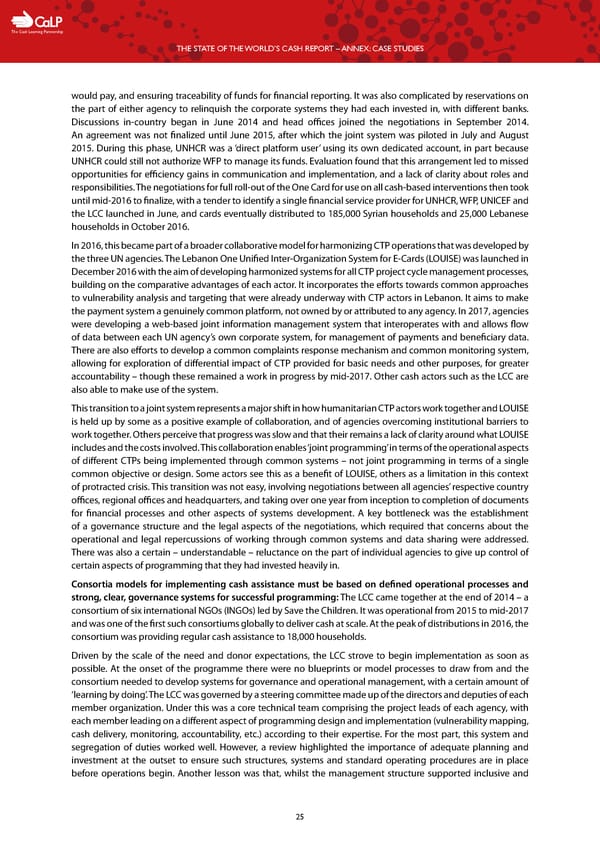C The Cash Learning Partnership THE STATE OF THE WORLD’S CASH REPORT – ANNEX: CASE STUDIES would pay, and ensuring traceability of funds for financial reporting. It was also complicated by reservations on the part of either agency to relinquish the corporate systems they had each invested in, with different banks. Discussions in-country began in June 2014 and head offices joined the negotiations in September 2014. An agreement was not finalized until June 2015, after which the joint system was piloted in July and August 2015. During this phase, UNHCR was a ‘direct platform user’ using its own dedicated account, in part because UNHCR could still not authorize WFP to manage its funds. Evaluation found that this arrangement led to missed opportunities for efficiency gains in communication and implementation, and a lack of clarity about roles and responsibilities. The negotiations for full roll-out of the One Card for use on all cash-based interventions then took until mid-2016 to finalize, with a tender to identify a single financial service provider for UNHCR, WFP, UNICEF and the LCC launched in June, and cards eventually distributed to 185,000 Syrian households and 25,000 Lebanese households in October 2016. In 2016, this became part of a broader collaborative model for harmonizing CTP operations that was developed by the three UN agencies. The Lebanon One Unified Inter-Organization System for E-Cards (LOUISE) was launched in December 2016 with the aim of developing harmonized systems for all CTP project cycle management processes, building on the comparative advantages of each actor. It incorporates the efforts towards common approaches to vulnerability analysis and targeting that were already underway with CTP actors in Lebanon. It aims to make the payment system a genuinely common platform, not owned by or attributed to any agency. In 2017, agencies were developing a web-based joint information management system that interoperates with and allows flow of data between each UN agency’s own corporate system, for management of payments and beneficiary data. There are also efforts to develop a common complaints response mechanism and common monitoring system, allowing for exploration of differential impact of CTP provided for basic needs and other purposes, for greater accountability – though these remained a work in progress by mid-2017. Other cash actors such as the LCC are also able to make use of the system. This transition to a joint system represents a major shift in how humanitarian CTP actors work together and LOUISE is held up by some as a positive example of collaboration, and of agencies overcoming institutional barriers to work together. Others perceive that progress was slow and that their remains a lack of clarity around what LOUISE includes and the costs involved. This collaboration enables ‘joint programming’ in terms of the operational aspects of different CTPs being implemented through common systems – not joint programming in terms of a single common objective or design. Some actors see this as a benefit of LOUISE, others as a limitation in this context of protracted crisis. This transition was not easy, involving negotiations between all agencies’ respective country offices, regional offices and headquarters, and taking over one year from inception to completion of documents for financial processes and other aspects of systems development. A key bottleneck was the establishment of a governance structure and the legal aspects of the negotiations, which required that concerns about the operational and legal repercussions of working through common systems and data sharing were addressed. There was also a certain – understandable – reluctance on the part of individual agencies to give up control of certain aspects of programming that they had invested heavily in. Consortia models for implementing cash assistance must be based on defined operational processes and strong, clear, governance systems for successful programming: The LCC came together at the end of 2014 – a consortium of six international NGOs (INGOs) led by Save the Children. It was operational from 2015 to mid-2017 and was one of the first such consortiums globally to deliver cash at scale. At the peak of distributions in 2016, the consortium was providing regular cash assistance to 18,000 households. Driven by the scale of the need and donor expectations, the LCC strove to begin implementation as soon as possible. At the onset of the programme there were no blueprints or model processes to draw from and the consortium needed to develop systems for governance and operational management, with a certain amount of ‘learning by doing’. The LCC was governed by a steering committee made up of the directors and deputies of each member organization. Under this was a core technical team comprising the project leads of each agency, with each member leading on a different aspect of programming design and implementation (vulnerability mapping, cash delivery, monitoring, accountability, etc.) according to their expertise. For the most part, this system and segregation of duties worked well. However, a review highlighted the importance of adequate planning and investment at the outset to ensure such structures, systems and standard operating procedures are in place before operations begin. Another lesson was that, whilst the management structure supported inclusive and 25
 The State of the World's Cash | Case Studies Page 26 Page 28
The State of the World's Cash | Case Studies Page 26 Page 28